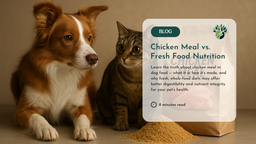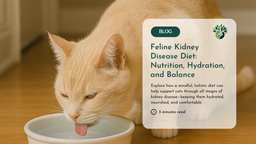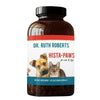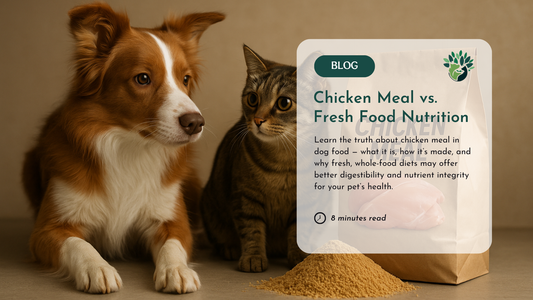Traditionally, the term "table scraps" often conjured images of leftover, less-than-ideal human food. However, as awareness about the dietary needs of dogs or cats has grown, so has the quality of the scraps being shared. We need to be mindful on choosing scraps that are not only safe for our pet, but also offer nutritional benefits.
While many conscientious pet owners may worry that indulging their furry friends with table scraps signals a lack of discipline, it's hard to deny those adorable eyes pleading for a taste.As a veterinarian, even I find it hard to resist sharing 'people food' with my own pets, and I extend the same recommendation to my patients.
In fact, transitioning your dog or cat away from store-bought, mass-produced pet food in favor of quality, human-grade ingredients is a move towards a healthier lifestyle. However, it's crucial to be informed about what you share, as not all table scraps are created equal. This blog will guide you through some vet-approved options that can enhance your pet's well-being.
Nutritious Vegetable Options
Vegetable table scraps can be a nutritious and wholesome addition to a pet's diet. Among the top choices are brassica vegetables like broccoli, Brussels sprouts, cabbage, cauliflower, collards, kale, and kohlrabi. Non-brassica vegetables are perfectly suitable too. When making the shift towards incorporating more food into your pet's diet, vegetables play a crucial role in the transition.
It's not necessary to adhere strictly to brassica vegetables. I strongly recommend utilizing locally available, seasonal options like zucchini, green beans, squash, pumpkin, and any other fresh produce you can find at your local farmer’s market.
Although coaxing your pet to consume vegetables might be a challenge, you can gradually introduce it to your pet’s diet.
Protein That You Can Feed To Your Pets
Here are some protein options suitable for your pet: Turkey breast, pork shoulder, beef, duck, and whitefish are all excellent choices that your dog will undoubtedly relish. However, it's important to be selective about the meats you offer. For instance, I tend to steer clear of ground products due to their lower protein content. If cost is a consideration, consider opting for an economical cut like chuck roast as a substitute for ground beef.
However, this might be surprising, but just like humans, pets can develop sensitivities to certain types of meat. Common culprits include beef, chicken, lamb, and fish. Identifying these allergens can be tricky through observation alone, which is why food sensitivity testing is crucial. This targeted approach helps pinpoint specific dietary triggers, allowing for a tailored, allergy-friendly diet.
Balanced Treats for Optimal Health
Table scraps should be viewed as treats rather than primary sources of nutrition. They can complement your pet's regular diet, adding variety and flavor. However, it's important not to go overboard. Moderation is key to maintaining a balanced and healthy lifestyle for your pet.
Steering Clear of Harmful Foods
While certain table scraps can be beneficial, it's crucial to be aware of foods that are harmful to pets. Onions, chocolate, grapes, and raisins are just a few examples of foods that should never be shared with your furry friend. Understanding which human foods are safe for pets is just as important as knowing which aren't.
Customizing to Your Pet's Preferences
Every pet is unique, and their preferences may vary. Pay attention to what your pet enjoys and adjust your offerings accordingly. Some pets may have sensitivities or allergies to certain foods, so always be vigilant and consult with a vet or a holistic pet health coach if you're uncertain about a particular ingredient.
The Shift Towards Quality Table Scraps
The shift towards quality table scraps is indicative of a larger movement towards holistic pet care. Recognizing that a pet's well-being is closely tied to their diet, we are taking a more proactive approach to our pet's nutrition. Sharing quality table scraps is not just about providing nourishment; it's also a way for pet parents to strengthen our bond with our furry companions.
By opting for the foods mentioned earlier, you're offering your pet a safe and nutritionally sound alternative. Making this dietary transition can extend beyond just providing meals; it's about elevating your pet's lifestyle. It's about recognizing that our pets, like us, benefit from whole, minimally processed foods.
Cook for Your Pet
Transitioning your pet from mass-produced pet food to a diet rich in high-quality, human-grade ingredients is a significant stride towards their overall well-being and contentment. It marks a shift from conventional, processed fare to a more personalized and nourishing approach. If your pet has developed a liking for table scraps and enjoys your food, you might want to consider preparing dedicated meals for them.
You can try to cook for your pet at home using The Original CrockPET Diet® Recipe. There are nutritious dishes using a variety of meats and vegetables to offer your pet a diverse range of options. Cooking for your pet allows you to have greater control over the ingredients they consume. You can tailor their meals to suit their specific dietary needs, ensuring they receive a balanced and wholesome diet. This level of customization can be particularly beneficial for pets with allergies, sensitivities, or specific health conditions.
















